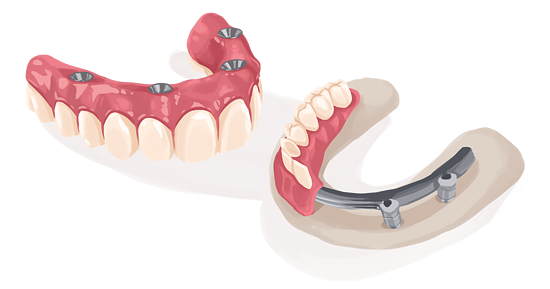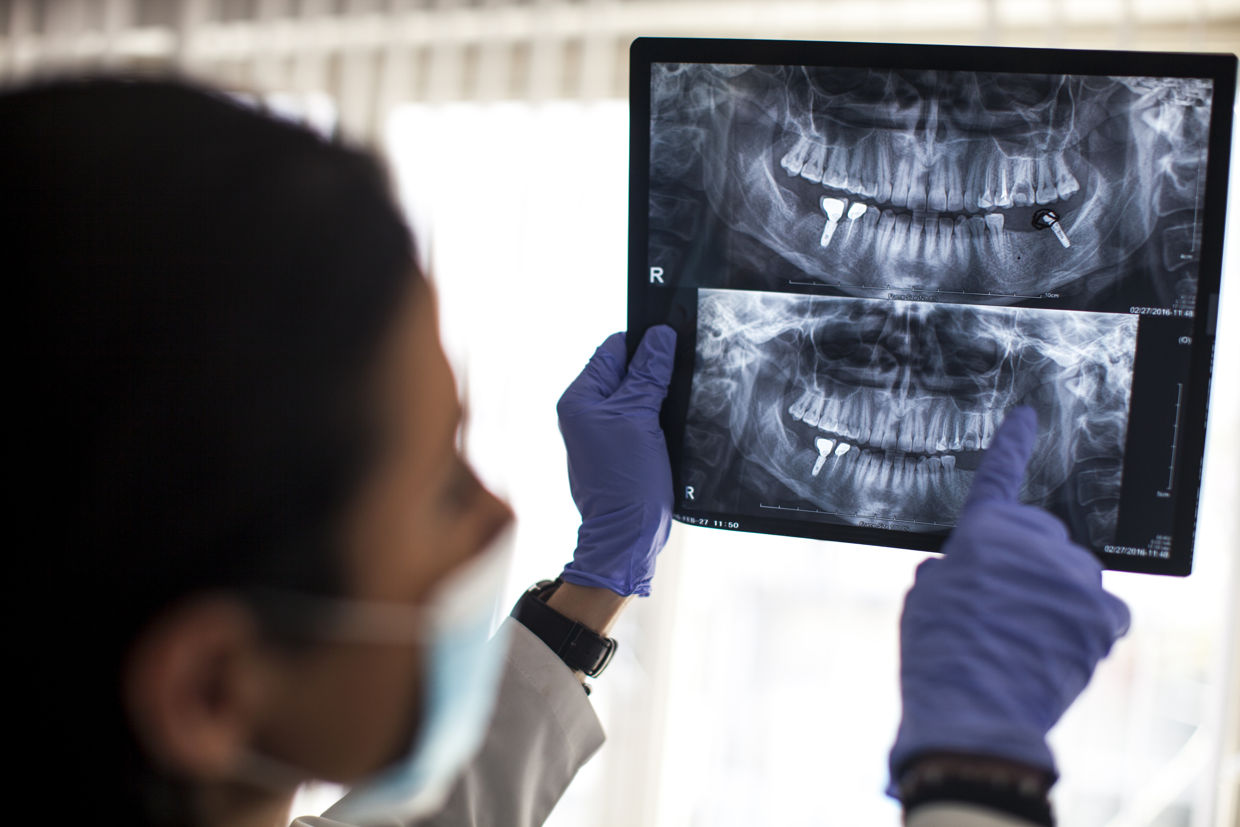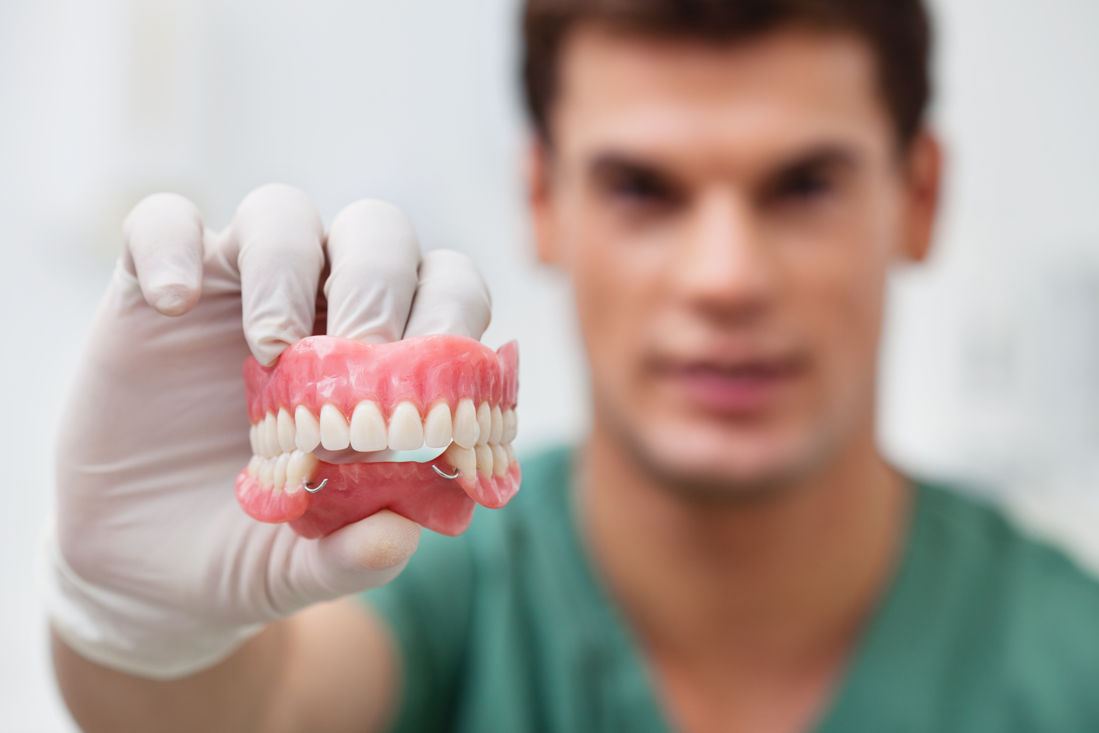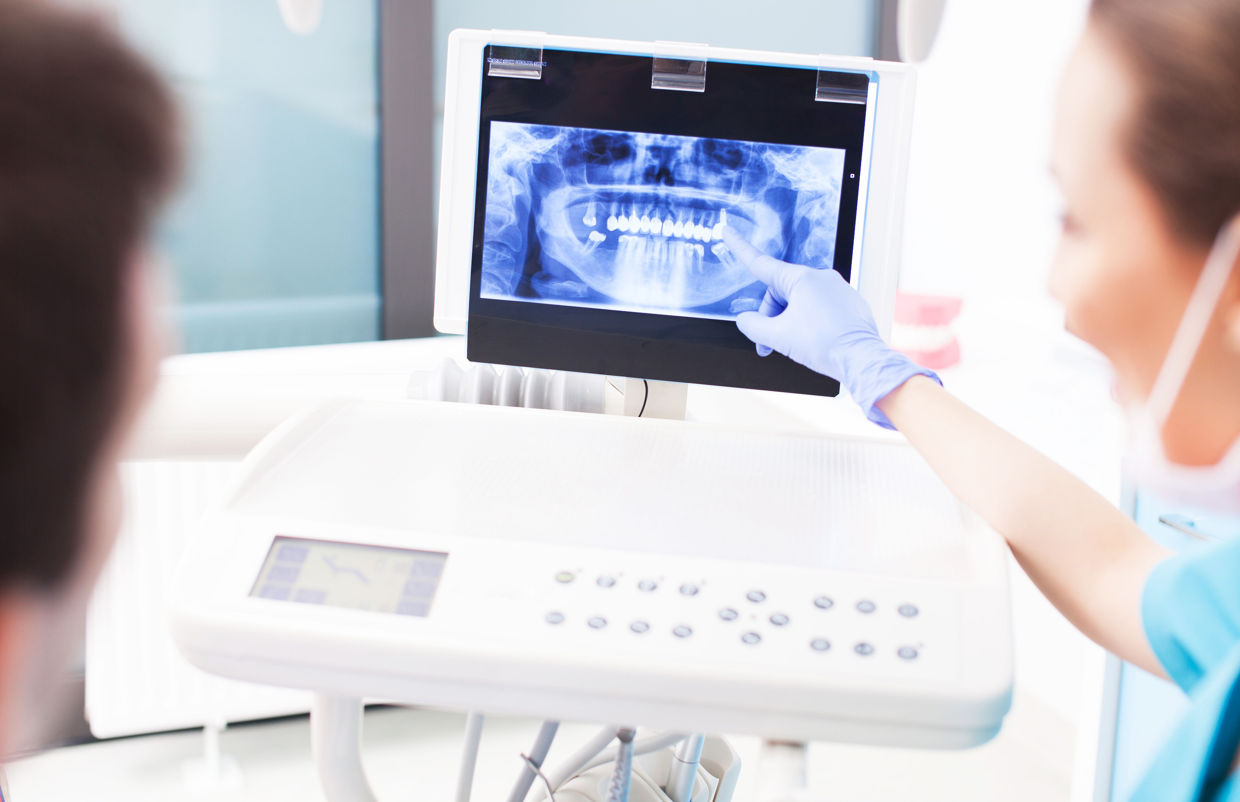What Should I Expect When Getting Immediate Dentures?
Teeth are one of the most important features of the face. Without them it is hard to speak, eat, and you may feel weird around company. With immediate dentures there is no need to function without any teeth, even right after surgery.
While it may not be a permanent solution, it is an option in-between visits to the dentist. So what are immediate dentures? How are they different from traditional dentures?
In this article, we will cover the question, “what to expect when getting immediate dentures?” to guide you through this transitional phase with confidence.
What are immediate dentures?
Dentures are the most common restoration for those who have to have all their teeth removed.
A conventional denture is made when all teeth are already missing. If you still have teeth, you must wait 6 to 9 weeks after extractions before making a conventional denture. This allows time for your gums and the bone of your jaw to heal and reshape.
Most people don’t want to go without teeth for that long. This is where immediate dentures are useful.
An immediate denture is made before extractions are done. It is placed in the mouth immediately after surgery. This allows you to go home with a full set of teeth the same day the others are removed.
Immediate dentures are designed to fit your gums the way they look while the teeth are still there. After the extractions, the gums and bone heal under the denture and change shape. Over time the dentures will not fit tightly any more and will have to be relined.
- Can replace teeth the same day as surgery
- Controls swelling and guides healing
- Never have to go without teeth
- Looks good and functions well
- Must be relined multiple times
- May need to be replaced after healing
- May slip or move
- Lasts at most 5-7 years
Immediate denture steps
As the name of this denture suggests, you will get them immediately. There are a few steps which must be taken to lead you there, however.
-
Initial consultation
The first thing you’ll do is meet with the dentist for the initial consultation. First, they’ll do a dental exam (which may include an X-ray and/or teeth impressions) to get a good idea of what they’ll be working with. Next, your dentist will come up with a treatment plan that includes the procedure steps, the timeframe for all of it, and what recovery will look like. If they think a bone graft is necessary, they’ll discuss that with you too.
-
Bone grafting
If you do need a bone graft, it could take 4-12 months after the graft before your jaw is ready and healed enough for the implants.
-
Treatment plan
The first appointment will be for diagnosis and treatment planning. X-rays will be taken of your jaws and any remaining teeth. The dentist should do a thorough cancer screening and exam of your mouth.
-
Taking impressions
Next you will have impressions of your mouth made. This involves putting a soft putty in a tray into your mouth. The putty sets into a rubber-like consistency and makes a perfect mold of your mouth.
-
Creating dentures
Then a bite relation record will be taken. This is a similar material, but just a small amount is used to show how your top and bottom teeth fit together. These records will be sent to a dental laboratory and used to create a custom denture.
-
Tooth extraction
At your next visit, you’ll have your tooth extractions done. Your mouth will be thoroughly numbed and the teeth will be removed.
-
Dentures placement
Immediately after surgery, your new dentures will be placed into your mouth. These not only serve as your new teeth, but also to cover the extraction sites and minimize swelling.
After the whole procedure, the dentist will give you an appropriate prescription for pain and send you home to recuperate.
What should you expect during your recovery period?
You should leave your new denture in place for the next 24-48 hours. This guides the healing of your mouth and prevents swelling. If you take them out, you may not be able to get them back in!
You should become familiar with what you can expect afterwards. So here is a list of necessary steps to take during the recovery period.
Dentist check-up
You’ll likely return to the dentist after a day or two. They will remove your denture and make sure everything is healing properly. This also gives them the opportunity to make adjustments to the dentures and treat any sore spots.
After this appointment, the denture should be worn all day but taken out each night. Clean your dentures and put them in an overnight soak.
This allows your gums to breathe and prevents fungal infections. These are some essential steps in how to take care of your dentures.
Denture adjustment
As time goes by, you’ll likely get more sore spots that will need adjustment. Your bite may also be adjusted to make it more comfortable.
These adjustments should only be done by the dentist. Never try grinding or carving on your denture at home! It may break or be messed up to the point you have to buy a new one!
You may also have tiny bone fragments work their way out of your gums. This is fairly common when you have many teeth taken out at once. Your dentist can remove these bone chips easily.
Denture reline
Your denture will likely become loose over time. This is due to the healing and reshaping of your jaws. As the bone reshapes, you will need to have relines done.
During a reline procedure, a soft material is mixed and placed inside your denture. The dentist will then put it inside the mouth where it will stay while the material sets.
The reline material fills in any space created by shrinking gums. It improves the fit and makes the denture more comfortable to wear. It is common to do 3 or 4 of these temporary soft relines.
After 6-9 weeks, your healing should be complete. A final hard reline can then be done. This reline is often sent to a dental laboratory and should last for a long time.
Immediate dentures cost
Immediate dentures usually cost slightly more than a traditional denture due to the procedure being more complicated. You also have the added costs of tooth extractions and relines.
Expect to pay:
| Procedure |
Cost |
| Immediate dentures |
$1500-$3200 per arch |
| Non-surgical extraction |
$75-$150 per tooth |
| Surgical extraction |
$200-$400 per tooth |
| Denture reline |
$200-$500 per arch |
The relines of an immediate denture may be included in the price of an immediate denture or may be charged separately. Check with your dentist so you know what to expect.
Additionally, you may need surgical procedures to reshape your bone. Large knots or bumps on the jaw must be removed in order to be able to wear a denture.
Normally, expected costs will be discussed prior to any treatment being done. This allows you to be prepared and make arrangements for payment. Payment plans or financing options are available at many dental offices.
Are immediate dentures permanent?
A quality, custom made immediate denture may last as long as a traditional denture once it has a final hard reline inside. Sometimes, however, the changes to your mouth are too significant and it is better to replace the immediate denture with a conventional one.
No denture is permanent, however. Even the best of dentures only last 5-7 years before needing to be replaced. This is one of several problems to consider when choosing between dentures and other restorations.
Instead of immediate dentures, you may want to consider the G4 Implant Solution. This revolutionary procedure can replace your bad teeth with permanent, beautiful fixed bridges that can last a lifetime. And it can all be done in one 24 hour period!
Click here to find out more about this remarkable alternative to immediate dentures!
How to Decide Between Dental Bridge or an Implant?
There are several options when it comes to replacing missing teeth. Removable appliances are often less expensive but come in and out of your mouth. Fixed restorations, like bridges or implants, remain in your mouth and feel more like natural teeth.
So, what’s the difference between a dental bridge and an implant? And which is the right choice for you? Read on to find out.
How do the both procedures look like?
Dental bridges attach to natural teeth on either side of the missing tooth. This “bridges” the gap and hangs an artificial tooth above the gum tissue.
-
An impression of the mouth is first taken. This is used later to make a temporary bridge.
-
After numbing, the teeth next to the space are shaped for the anchoring crowns, called abutments.
-
An impression of the prepared teeth is then taken to send to the dental laboratory.
-
A temporary bridge is made out of dental acrylic to wear while the permanent restorations are made. This may take a week to two weeks.
-
Once complete, the temporary bridge is removed and the permanent bridge can be cemented in place.
Dental bridges look great and only take a few weeks to complete. On the other hand, additional healthy teeth must be cut down for crowns. Bridges are also notorious for trapping food underneath.
Dental implants attach to the bone of the jaw instead of adjacent teeth, just like a natural tooth root. This allows for a great looking tooth replacement without having to damage other teeth. But a dental implant procedure requires surgery.
-
An impression of the mouth is first taken. This is used later to make a temporary bridge.
-
After numbing, the teeth next to the space are shaped for the anchoring crowns, called abutments.
-
An impression of the prepared teeth is then taken to send to the dental laboratory.
-
A temporary bridge is made out of dental acrylic to wear while the permanent restorations are made. This may take a week to two weeks.
-
Once complete, the temporary bridge is removed and the permanent bridge can be cemented in place.
Which option looks better between dental implant vs bridges?
Both dental bridges and implants can look very natural! They are both topped with custom, laboratory-made crowns covered with porcelain. The main differences are the gum line and the spaces between teeth.
Dental bridges can sometimes have a gap underneath them, between the bridge and gums. This affects the natural appearance and can also act as a food trap.
It’s also sometimes obvious that the teeth on a bridge are all connected together.
Dental implants are attached to the gums, so there is no space like in a bridge. Occasionally, however, the metal implant can appear as a dark spot on the gums.
Which restoration is more durable between dental implant vs bridges??
Dental bridges and dental implants are both cemented in place. Unlike dentures or partials, these restorations do not move when you talk or eat.
A dental bridge sits on natural teeth. Over time, these teeth may decay or have bone loss around them.
The shape of a natural tooth under a crown may not hold the crown very well either. You are dependant on the dental cement to hold the bridge in place.
Because of these factors, dental bridges usually last 5-7 years on average.
A dental implant is fused to the bone. The abutment head that is under the crown is machined to hold onto crowns very well. And these metal abutments cannot decay like natural teeth.
A dental implant can often last a lifetime.
How to take care of dental implants and bridges?
Taking care of dental implants and bridges is mainly a matter of keeping them clean.
Implants can’t decay, but they can still get gum disease. Keeping the area clean can keep bone levels healthy and implants solid for many years.
Bridges must also be kept clean. It is a little more difficult due to the fact that bridge teeth are fused together. You cannot floss between the teeth.
This is in addition to the fact that bridges tend to trap food underneath them. Special floss threaders or a water flosser may help keep it clean. Otherwise, you risk bone loss and decayed tooth roots.
What about the costs of dental implants and bridges?
Depending on the number of teeth being replaced, the cost of a bridge can be similar to the cost of dental implants. A single implant and crown is about the same price as three crowns needed for a bridge, $5,000 on average.
So, which option is better choice?
Both dental implants and dental bridges are fixed, stable and natural-looking options for teeth restoration. The cost of restoring a single tooth is also comparable.
To summarize differences between them, let’s take a look at the table below:
- No surgery required
- Sits on natural teeth
- Lasts only 5-7 years on average
- Have to cut down adjacent teeth
- Can sometimes have a gap between the bridge and gums
- Requires surgery
- Fuses to bone
- May last a lifetime
- Conserves adjacent teeth
- Metal may show through gums
For replacing multiple teeth use a mix of both solutions
We have discussed replacing a single tooth, but what about multiple teeth. Or all teeth?
Bridges over implants do not have the same issues as on natural teeth. Implant bridges take advantage of both restorations and have a long history of success.
Full arches of teeth can be replaced with as few as four implants and a fixed bridge.
In general, teeth replaced with implants will have fewer issues over time than a long bridge on natural teeth. Natural teeth as anchors simply have more things that can go wrong.
The best example of this is the G4 Implant Solution. Dr. Golpa has perfected the art of full mouth implant placement.
The G4 procedure can replace an entire mouth of teeth with beautiful, fixed implant bridges in just one 24 hour period. Visit our website today to find out if the G4 Implant Solution is right for you!
How Safe Are Dental Implants?
Dental implants have many advantages over other ways of replacing missing teeth. Even so, there are still things to think about before choosing to do implants.
Let’s look at what you need to be aware of and how to prevent bad outcomes from implants.
In this guide, we delve into the considerations for the safety and success of dental implants, addressing the vital question, Are dental implants safe? to empower you with informed choices for your oral health journey.
Dental implants benefits
Dental implants are considered the closest thing to having natural teeth. They look good, are comfortable, and function well when chewing and talking. Here are some of the reasons implants have such a good reputation:
High success rate
Dental implants are one of the most reliable restorations in dentistry, with an over 95% success rate. In most situations, dental implants work well without any significant issues.
Stability
Implants have such a high rate of success because they actually fuse to the bone and anchor in place. This makes them much more stable than removable dentures that rest on the gums. Patients usually find teeth implants much easier to eat and talk with than conventional dentures.
Conservative
Traditional bridges require cutting down adjacent teeth to act as anchors for missing teeth. Since implants are instead anchored in bone, much like natural tooth roots, adjacent teeth can be preserved.
Maintains bone
Without teeth, the bone of the jaw slowly absorbs back into the body. This leads to bone that is thin and fragile. Dental implants act like natural teeth to stimulate and maintain bone in the jaw.
Long lasting
Since they are most often made of titanium metal, implants do not get cavities or decay. They fuse so securely to the bone that they do not normally come loose. As a result, dental implants can often last a lifetime.
Cost efficient
Additionally, dental implants are very cost efficient. Although they usually cost more on the front end, they usually don’t have to be replaced every 5-10 years like other types of teeth replacement.
Dental implants problems
Although dental implants can seem like an ideal restoration for replacing teeth, there are some risks involved. These complications are rare, but they do happen occasionally.
Infection
Implant placement may involve several surgeries. Any time a surgical site is open, there is the chance of bacteria getting somewhere it shouldn’t. An infected implant may have swelling or a bump on the gums, or it may only be seen as a dark spot on x-rays.
Rejection
Occasionally implants will not fuse to the bone. This may be due to infection, auto-immune disorders, or other issues. In these cases, the implant may come loose from the jaw.
Placement issues
If an implant is not placed correctly, there may be damage to nerves or blood vessels. It may also result in damage to the sinus cavities or perforations through the bony walls of the jaw. 3D images and surgical guides have made implant placement much safer and predictable.
Gum disease
Although implants cannot get decay, they are still subject to periodontal disease and bone loss. Gum tissue may shrink back to expose the metal of the implant. The bone around the implant may also be lost. Bone loss is the most common way that implants fail.
Fracture
Titanium implants are extremely strong, but so are your jaw muscles. If you are prone to clenching or grinding, you can actually break an implant. You might also fracture the bridge or denture on top of the implant.
Dental Implant Risk factors
Some conditions increase the risk of implant failure.
Patients with untreated decay, poor oral hygiene, or gum disease should have those issues treated before implant placement.
Smokers and people with uncontrolled diabetes have a decreased ability to heal. Implants may take longer to integrate and surgical sites may be more prone to issues.
Patients who have been without teeth for a while often have decreased amounts of bone in the jaw. Additional procedures like sinus lift surgery or bone grafting may be needed to place an implant.
How can you improve your chances of success?
There are several things you can do to help your implant placement be successful:
- Be focused on having good oral hygiene before and after your surgery. A cleaner mouth means lower chances of infection or gum disease issues later on.
- Let your doctor know if you clench or grind your teeth. It may affect how they design your implant restoration.
- Work with your healthcare provider to get your diabetes under control. They can also help you stop smoking with cessation programs and medications.
- One of the most critical steps you can take is choosing the right doctor to place your implants. Be sure you pick an experienced dentist that has done many implant placement procedures.
An experienced implant dentist like those at G4 by Golpa has placed hundreds of implants and will know how to best plan your case. Our doctors have perfected the same day implants procedure, allowing you to get a full mouth of new teeth in a single 24 hour period.
Contact us to learn more about how G4 By Golpa can help you get your smile back!
Why Do Dentures Need a Reline?
Over time, your jaw may change and dentures may not fit as well as they originally did. This can create a lot of issues with your mouth. So what is the solution?
In this guide, we explore the key to resolving denture fit problems, shedding light on the process of how to reline dentures for a comfortable, what they do, types of relines and snug fit ensuring optimal oral health and functionality.
Changing bone
When teeth are first removed, it leaves holes in the bone where the roots of the teeth once were. These holes, called extraction sockets, fill in as healing occurs.
The bone of the jaw gradually reshapes over time while healing. Most changes happen in the first four to six months after tooth removal.
Small changes can continue to occur for years more. Tooth roots normally stimulate bone and keep it dense and strong.
Once teeth are removed, the bone is absorbed by your body. Jaws with no teeth can become smaller and more fragile over time.
What do relines do?
There is no way to predict how your jaws will reshape as the bone heals. If you need teeth removed, dentures are usually made to fit your jaw as it is now.
As your jaws change over time, the dentures will become loose. Relines are made to fill in the space left under your denture as bone is absorbed.
A good fit is needed with dentures to make them stable. It also prevents sore spots, fungal infections, and gum tissue overgrowth.
Dentures may need to be relined several times when you first get them. Even if you have been without teeth for years, relines may be needed as changes occur. To find out more about dentures, click here.
Types of relines
There are several kinds of relines available. Which type you should get depends on your individual needs.
Temporary reline
A temporary reline is usually done when significant changes are expected. This is a soft, rubber-like material your dentist can do in his office.
Temporary relines are often placed soon after tooth extractions with an immediate denture. They are also used when the gums are irritated or swollen from poorly fitting dentures.
These relines don’t last long and will need to be replaced with another more permanent reline once the jaws have had time to heal.
Soft reline
A soft reline is used when a patient gets frequent sore spots or wants a more cushioned feel to their denture. It is soft like a temporary reline but is made to be much tougher and longer lasting.
Although they last longer than a temporary, soft relines don’t last forever. Expect to replace a soft reline every one to two years.
Hard reline
A hard reline is made from essentially the same material as the body of a denture. It is a hard acrylic and will last for many years.
A hard reline is done if the patient is tolerating dentures well. They aren’t as cushioning as a soft reline but their long life and durability make them a good choice for most people.
How often should you reline denture?
You should reline a denture when it begins to feel loose or previous relines begin to wear out. Wearing a denture that does not fit snuggly can create many common problems, including sore places, infections, or puffy, overgrown gums.
Expect a temporary reline to wear out every few weeks and a soft reline about every one to two years. A hard reline done at a dental laboratory will last for years, but you still may need to replace it due to bone changes.
If bone changes are substantial or the teeth become too worn, it may be time to get a whole new denture.
How to reline denture?
Relines are best done at your dentist’s office, but an at-home kit is an option if cost or access to a dentist is an issue.
Professional denture reline
Both kind of professional denture reline, soft and hard, are done differently.
- Your denture is roughened on the inside and an adhesive is placed on the acrylic.
- The soft reline material is placed into the denture and it is seated in your mouth to cure.
- Once it has stiffened, the denture is removed and trimmed.
- An impression of your jaw is taken inside your denture.
- The whole denture is then sent off to a dental laboratory to have the durable reline material placed.
- Usually, the denture can be returned to the patient the next day.
DIY denture reline kit
If cost or ability to get to a dentist are an issue, there is a do-it-yourself kit available at many drug stores. These work similarly to the soft relines mentioned above.
Be advised that these kits do not last very long and must be done correctly. If the denture is not seated precisely, you may create more problems than you solve.
Denture reline cost
Many people get dentures thinking it is the last dental treatment they will need. They are unaware than dentures need relines, eventual replacement, and may have other additional costs involved.
A soft reline done in the dental office only takes one visit and may cost $300-$400. A laboratory reline means being without your denture for one night and costs around $500, but will generally last much longer.
| Reline type |
Cost |
| Soft reline |
$300-$400 |
| Hard reline |
$500 |
Can you avoid denture reline?
Most relines are needed because the bone of the jaw is no longer stimulated by teeth. That is why it is worth to consider other teeth replacement options.
Dental implants are seen as a better way to replace teeth. They are great anchors for making stable teeth replacements. They also provide stimulation to the jaw to prevent bone loss.
Implants can be used to create dentures that snap into place. While more stable, these dentures do still come in and out of the mouth. They also need regular maintenance on the attachment points and will have to be replaced every five years or so, much like traditional dentures.
An alternative is the G4 by Mike Golpa. This revolutionary treatment option features permanent bridges supported by just four dental implants. They are beautiful, stay in like natural teeth, and can usually be placed in just one 24 hour period!
And since the implants help maintain the bone, the only reline that is normally needed occurs six months after any teeth are removed. This helps prevent food from getting trapped under the bridges.
Once complete, G4 restorations only require normal cleanings and checkups to maintain them for a lifetime!
Types of Dental Bridges: Pros, Cons and Cost
If you’re looking into getting a dental bridge, you may already know about all the different kinds. Whether you do or not, this article will take you through an overview of each, their pros and cons, and what they cost.
Ready to learn about the types of dental bridges available?
So which bridge will you cross?
1 – Traditional dental bridge
A traditional dental bridge is the most common type of bridge people get. They have as few as one tooth and attach to the prosthesis. The whole contraption attaches to your surrounding natural teeth via abutments, which are cemented to the natural teeth.
So if you have natural teeth on both sides of the gap that needs a fake tooth, you can get a traditional bridge.
A traditional bridge usually costs between $2,000 and $5,000, which includes the prosthesis with a crown per abutment tooth.
- Very popular and reliable dental prosthesis
- Works well in most patient cases
- Comparatively affordable
- The dentist will need to remove the enamel of the supporting teeth to place the crowns over top of them
- The removed enamel will never grow back, so once you get a traditional bridge, you’ll always have to have a bridge
2 – Cantilever dental bridge
Cantilever bridges are similar to traditional bridges, the main difference being that the prosthesis is supported by just one abutment on just one side of the mouth.
So if you have just one natural tooth next to the gap left by a missing tooth, you can get a cantilever bridge.
But like traditional bridges, the dentist will need to remove enamel to prepare the supporting tooth.
A cantilever bridge costs between $2,000 and $5,000, which includes the prosthesis with a crown per abutment tooth.
- Works if only one tooth is next to the gap left by a missing tooth
- Most affordable type of dental bridge
- The dentist will need to remove the enamel of the supporting tooth to place the crown over top of them
- Because it attaches to just one tooth, it can more easily lead to a fractured tooth or loose crown
3 – Maryland dental bridge
If you’re looking for a more conservative option to a traditional bridge, you can go with a Maryland dental bridge. It is a good choice for replacing the missing front tooth.
This bridge is held in place by a framework (two wings), usually made of porcelain or metal. The framework is attached to the back of the two teeth next to the gap. But there is the one condition – these teeth must be healthy, with no cavity.
A Maryland bridge can cost between $1,500 and $2,500, including the prosthesis with the framework/wings that attaches to the abutment teeth.
- Because the framework is bonded to the teeth, the dentist doesn’t need to remove enamel
- A more conservative option to a traditional bridge
- May not be as strong as a traditional bridge
- The framework may get in the way of your bite or gums
4 – Implant-supported dental bridge
The last option we’ll cover is an implant-support bridge. This is a good option for people who have more than just one tooth missing. Instead of using surrounding teeth as support, this bridge is supported by dental implants.
Usually there’s one implant per missing tooth, but if that’s not possible, it can use two implant-supported crowns.
An implant-supported bridge can cost anywhere from $5,000 to $6,000 for two implants covering 3-4 teeth.
- Feels very sturdy because it’s supported by implants
- Many times does not require removing any enamel
- Can choose a removable bridge or a fixed bridge
- Requires two surgeries — one to place the implants and the one to place the bridge
- Can be very expensive, the most expensive bridge on this list
Is it possible to get a bridge for full mouth replacement?
Here’s the thing: if you have multiple missing teeth and you want a truly permanent solution, these options may not be exactly what you need.
The best type of bridge for you may very well be the G4 implant procedure. It’s an upgraded and improved version of the All-On-4 solution. Dr. Golpa is the brains behind the G4 solution and has since done the procedure over 5,000 times.
G4 offers a dental bridge supported by four implants and it’s placed in just one day. So it’s both durable, reliable, and done quickly. It’s a full-mouth replacement done in a day that will last many, many more days.
Common Denture Problems and How to Deal with Them?
Dentures and problems just go together. As good as a set of fake teeth are, they, like anything else, is going to have issues.
So what are the most common denture issues? And how can you deal with them?
In this guide, we’ll learn about the common dentures problems how to solve them, offering insights into prevalent challenges and providing practical solutions to ensure a seamless denture-wearing experience.
What are the most common denture problems?
If you’ve ever experienced one of these common denture problems, you’re not alone. These are the most common issues denture wearers experience.
Dentures slipping
Sometimes you may feel your dentures slipping or shifting. Usually it happens when you smile, laugh, cough, eat, or talk.
A quick fix in the moment of slippage is to bite down (which repositions them) and swallow. We’ll talk about a long-term solution below.
Gums & mouth soreness
If you’re dentures become loose, they can start to rub against the gums or inside or your mouth. This can lead to inflammation, which, if not treated promptly, infection.
To much saliva
Dentures are a new object in your mouth, so it’s completely normal for your mouth to produce more saliva. Eventually, they’ll adjust, but at first you may find you have extra spit hanging around.
Difficulty eating & speaking
If you’re an experienced denture wearer, you probably know that it takes practice to learn how to eat and talk with dentures. Over time, you’ll learn how to hold the dentures in place with the muscles in your mouth.
When it comes to speaking with new dentures, they may feel unnatural and can get in the way of how you’re used to talking.
Also, food can sometimes get stuck under your dentures, which is annoying.
Plus, you may experience less of a taste with food and drinks because your palate is covered by the dentures. Many people don’t realize the palate actually has taste sensors.
Bad breath
If your dentures aren’t sealed properly, food particles and drink residue can get up underneath and sit there. That, if not cleaned in time, leads to bad breath.
Not cleaning your dentures frequently or correctly can lead to bad breath, even if food particles don’t get stuck to them.
Bone loss
Over time, your gums and jawbone deteriorate. So after a while, you may find your dentures no longer fit — this could be because you’ve experienced bone loss.
Jaw joint changes
If your jawbone atrophies, this can affect the jaw joint. And, unfortunately, the jawbone cannot form new bone, so once it’s worn away, it’s gone.
And if your jaw joint changes, that may affect the way your dentures fit your mouth.
How to solve denture problems?
Okay, now onto the solutions to the above problems. These fixes can help solve multiple issues you may be experiencing.
Eat soft food
If you’re experiencing trouble eating, you can try eating softer foods.
Avoid hard or sticky foods — that will just make things more difficult. Taking smaller bites and chewing slower can help as well as using both sides of your mouth when you chew.
The longer you have your dentures, the easier it will get to eat. It’s just a matter of getting use to them.
Use denture adhesive
Using denture adhesive is a great way to hold your dentures in place — most people use it because holding the dentures in with your mouth muscles alone can be too difficult.
This can help solve slippage as well as bad breath because it’s less likely that food particles will get up under the dentures.
Consider denture reline
A denture reline is when your dentist adds to lining to the surface that sits against your gums. They’ll basically reshape your dentures to fit better.
You can get a soft reline or a hard reline. The former uses a liquid polymer that’s layered on the denture to provide a sort of cushion. The latter uses a harder material and is usually a more permanent solution.
Either way, a reline can help with uncomfortable or slipping dentures.
Take care of your dentures
You must have the same level of care for your dentures that you’d have for your natural teeth. But it can be tricky knowing what to do and not do, so here are some tips for taking care of your dentures:
- Don’t sleep with your dentures unless your dentist advises it
- Be careful when you’re handling your dentures — if you drop them, they could break
- Clean your dentures every day soaking them in a denture cleaner overnight, cleaning them every morning before you put them in with a denture brush
- Clean your mouth every day, massaging your gums, the roof of your mouth, and tongue with a soft-bristled brush
- Don’t use toothpicks as those can damage your dentures
Practice pronunciation
Right after you get dentures, it will probably feel weird and be difficult to speak. But just be patient. Try speaking slowly and work on your pronunciation.
It may feel silly at first, but it can be very helpful. It will make you more familiar with how to talk with your new set of teeth.
Choose G4 by Mike Golpa
A much more convenient and permanent option to dentures is the G4 implant solution.
It’s basically the All-On-4 procedure but better and more long-lasting. Dr. Golpa and the team have performed over 5,000 of this special G4 procedure, so we’ve honed it until it’s the best it possibly can be.
For more info, contact us to see if you might be a candidate.
What Are Most Common Causes of Dental Implant Failure?
Nothing is perfect. Even if the most experience doctors use the most proven methods, complications can still happen.
And dental implant failures show us this is true in the dental world too. So if this happens to you, what do you do?
In this insightful exploration, we delve into the complexities surrounding dental implant setbacks, shedding light on the causes of dental implants failure and offering guidance on how to navigate through such instances with informed decisions.
Signs of dental implant failure
The most common sign that a dental implant has failed is mobility, if the implant is moving. Even if it’s just slight (i.e. micro-movements), it could have failed and will only move more and more as time goes on. If you notice movement at all, it’s time to speak with your dentist.
Other indications that an implant has failed are pain and swelling happening over two weeks after the surgery. You could also experience infection, but not always.
If your dentist notices signs of dental implant failure, they’ll most likely order an X-ray of your mouth. In the case of a failed implant, the X-ray will show them bone loss around the implant.
Why do dental implants fail?
There are many reasons dental implants can fail. When it comes to short-term implant failures, most of the time it’s because the bone did not successfully integrate with the bone (i.e. osseointegration).
This can happen because of:
- diabetes,
- low bone density,
- poor oral hygiene,
- gum disease,
- or if the patient continued smoking after getting the implant.
Another possibility is that the body simply rejected the implant as a foreign body, although this is rare.
As far as long-term implant failure, the most common cause is peri-implantitis, which is a chronic infection in the gums that affects the implant’s supporting bone. If this happens, the symptoms show as:
- pain,
- discomfort,
- pus excretion,
- or bleeding of the gums.
Other long-term failure causations can include an acute injury to the site, broken screws, loosening of the abutment, or a fractured restoration. All of these issues can be correct though.
Overall, dental implants have a failure rate of about 5%, so it’s unlikely that you’ll experience an implant failure.
Dental implant failure treatment
Taking care of a dental implant failure depends on what caused it. What you should do contact your dentist, then they will talk with you about the best treatment options.
For example, if the implant is infected, you can try to clean the area regularly until you can visit your dentist. However, if the implant is failing because it’s damaged, your dentist may need to get a bone graft to add more support to the implant.
In severe cases of failure, the entire implant may need to be replaced, which is basically like starting from scratch.
Can failed dental implant be replaced?
Yes, a failed dental implant can be replaced. However, replacement implants don’t usually do so well.
If you need to get your implant removed, you have a tough choice ahead of you. You can get some sort of removable prosthesis, but that’s not the best option according to most professionals.
If you had just one implant fail and you also have nearby natural teeth that can be anchors, you can possibly get a fixed partial denture.
But most patients choose to simply get another dental implant. The problem is the success rate ranges between about 70% and 90%, much lower than the success rate of 95% for the initial implant procedure.
And because of this, many dentists charge extra to replace implants. It’s too risky, they say.
But with Dr. Golpa and his team, they will replace your G4 dental implant at no additional cost including any necessary corrective procedures (within the warranty timeframe).
Other doctors may consider implant replacement an exception, but for us it’s actually routine.
Prevention of teeth implants failure
The best defense is a good offense, as they say. In other words, prevention is the best treatment.
Oral hygiene
Before you notice any symptoms of failure, make sure you’re taking good care of your implants by keeping a good oral hygiene routine. Brush and floss and use antibacterial mouthwash, as you would with your natural teeth.
Proper diet
You may also need to adjust what you eat and drink too. There are bone-healthy foods like milk, eggs, and fish that you can incorporate into your diet.
And it’s probably better to avoid really hard foods or candy, at least until your dentist says it’s okay.
Regular check-ups
You’ll also need to have regular visits with your dentist to make sure everything is looking good, preferably every six months.
Experienced dentist
The quality of the dentist and surgeon is crucial — it’s probably the most important factor in avoiding an implant failure.
Fortunately, the doctors on Dr. Golpa’s team are some of the most experienced at this, specifically placing G4 implants, which is a new and improved version of the traditional All-On-4 procedure.
Will I Have Dental Implant Pain After Surgery?
When you look at what goes on during a dental implant procedure, everybody’s first thought is, “Will it hurt?” And that’s a fair question.
Will you have dental implant pain? If so, how long will it last? Is it an indication that something’s wrong? The fear of pain can often overshadow the excitement of restoring a confident smile.
Addressing concerns about dental implant pain is crucial in demystifying the process and ensuring patients make informed decisions about their oral health.
Do dental implants hurt?
For most patients, there is no little to no pain.
Many people who get implants go back to work the same day. Usually, your dentist will recommend taking an over-the-counter pain killer a few times a day and you may experience some soreness.
But for the most part, dental implants will not be very painful.
Teeth extraction
A tooth extraction is when the dentist must remove one or more teeth because of damage or decay. They may also remove a tooth if that spot needs to be used for one of the implant anchors.
Bone grafting
Bone grafting is when the dentist takes bone from somewhere else in your body or uses a synthetic bone to add more of a foundation for the implant.
If this is necessary, it may take several months for the jaw to grow enough new bone in order to support an implant.
Surgery
Any time surgery is needed, the dentist will use anesthesia. You may either be sedated or just receive a powerful local anesthesia and stay awake during the procedure.
Because of the invention of anesthesia, you won’t feel anything during the surgery and the discomfort afterwards will be minimal.
How long does pain last after dental implant surgery?
When it comes to pain after getting dental implants, how long will it last?
Well, immediately after the surgery and in the following days, you may experience swelling, bleeding, and bruising. These symptoms typically hang around for about 48 hours before they start to diminish.
If you have dental implant pain after 5 days, that’s okay. But if the symptoms persist longer than 10 days, you should contact your dentist for a follow-up.
If you’re experiencing dental implant pain after 3 months, you may be experiencing early dental implant failure.
An implant can fail due to many reasons, like:
- gum disease,
- rheumatoid arthritis,
- diabetes,
- an inexperienced surgeon,
- or if you continue to smoke after getting the implant.
If you have dental implant pain years later, that’s what we’d call a late dental implant failure.
This can happen because of:
- nerve damage,
- if your body rejects the implant as a foreign body,
- if the implant protrudes into the sinus cavity,
- or if you experience an acute injury to the area of the implant.
Some indications of a failed implant, on top of the pain, include infection at the implant site, micro-movement of the implant, or having an allergic reaction.
Some other symptoms to watch out for include:
- trouble chewing
- inflammation of the gums
- gum recession
- swelling that doesn’t go down
However, only 5-10% of dental implants fail, so it is a rare occurrence.
How to reduce dental implant procedure pain?
Here are some general tips for reducing pain in the first few days after surgery:
- Apply ice over the swollen areas.
- Use warm water mixed with a half teaspoon of salt — don’t swish or gargle, just let it sit in your mouth for a bit.
- If the bleeding is not being subdued by just gauze, take a tea bag (black tea), wet it, and use it on the wound like you would gauze — the tannic acid helps speed up the clotting process.
- Avoid hot foods for the first few days as heat opens up the blood vessels, which will lead to more bleeding.
- Feel free to eat ice cream! The soft texture is gentle on the wound and the coldness of it will help the swelling go down.
- Rest a lot.
Find an experienced dentist
If you’re looking to have minimal post-op pain, the best thing to do is to do pre-op research. By finding the most experienced dental professional you can afford, you’re lessening the likelihood of severe pain or even implant failure.
For example, G4 dentists who work with Dr. Golpa are some of the most experienced in the country. In fact, the whole G4 dental implant procedure is much faster, more reliable, and the recovery period is drastically shorter than with traditional implants.
Whatever type of implant operation you get, make sure you follow the surgeon’s instructions to the letter, which will include pain killers, dietary restrictions, and specific oral hygiene methods. They know what they’re talking about, so it’s best to listen to them.
Dental Implant Process: What You Need to Know?
The dental implant procedure is a big deal. You’re getting metal screwed into your jawbone and a new set of fake teeth placed in your mouth. It’s no surprise you’re looking to find out as much info about it as possible.
This article is tailored to be your comprehensive guide, unveiling the nuances of the dental implant process step-by-step providing you with the comprehensive insights you need before embarking on this transformative journey.
Are you a candidate for a teeth implant?
Dental implants are for people who are missing multiple teeth or are suffering from tooth decay.
Here’s a complete list of situations when you may very well be a good candidate for a teeth implant:
- If you’re missing multiple teeth
- If your jawbone is fully developed
- If you have enough bone to securely fuse with the implants
- If you have generally good oral health
- If you don’t have health problems that could jeopardize bone healing
- If you’re not able or not willing to wear dentures
- If speaking is too difficult
- If you’re willing to commit several months for the entire implant process
- If you don’t smoke tobacco or use tobacco products
Dental implant process step-by-step
Taking into consideration all of the stages and how long each could last, the whole dental implant procedure can take up to two years or longer.
Here’s a dental implant process step-by-step guide through the whole thing.
-
Initial consultation
The first thing you’ll do is meet with the dentist for the initial consultation. First, they’ll do a dental exam (which may include an X-ray and/or teeth impressions) to get a good idea of what they’ll be working with. Next, your dentist will come up with a treatment plan that includes the procedure steps, the timeframe for all of it, and what recovery will look like. If they think a bone graft is necessary, they’ll discuss that with you too.
-
Bone grafting
If you do need a bone graft, it could take 4-12 months after the graft before your jaw is ready and healed enough for the implants.
-
Dental implant placement
The next stage is the placement of the implants, which is a metal screw that’s inserted into your jaw bone. This is the anchor on which the whole prosthesis will sit. Placing the implants can take a couple hours, but you’ll be asleep the whole time.
-
Healing collar placement
After they place the implants, it can take up to five months for your lower jawbone to heal and seven months for the upper jawbone to heal. Once your bone is healed and has fused with the implants, you’ll get something called a healing collar. You may also need a temporary crown. The healing collar, a piece of round metal, goes on top of the implant and allows the gum tissue heal properly, keeping them from growing over the implant. The collar stays on for 10-14 days.
-
Abutment placement
Once your tissue is healed, the dental professional will remove the healing collar and place the abutment. This is the part that screws into the implant and on which will attach the crown. They’ll probably give you a temporary crown to wear for about 4-6 weeks while your custom-fit permanent crown is being made.
-
Crown placement
The last step in this process is to place the crown, which is the part that people will see, the part that looks like a real tooth. They will screw it onto the abutment and cement it in place.
Wondering how long does dental implant procedure take?
Taking into consideration all of the stages and how long each could last, the whole dental implant procedure can take up to two years or longer.
What to expect after dental implant surgery?
As with any oral surgery, you’ll most likely experience pain, swelling, maybe some bruising, and minimal bleeding.
First days after surgery
Directly after the surgery, your dentist will send you home with some instructions for the following 72 hours, including how to manage the symptoms. If the symptoms persist for a long time, speak with your dentist.
The following days
Following the surgery, you’ll want to treat your new teeth like you would natural teeth.
Go to your dentist on a regular basis, brush 2-3 times a day, floss, rinse with non-alcoholic mouthwash, don’t smoke cigarettes, or drink lots of alcohol. The implants are literally implanted into your bone, so they’re not going anywhere.
During your regular checkups, your dentist will also get X-rays of your mouth. What they’re looking for is how the implant, abutment, and crown are working well together.
Possible complications
There are some possible complications you should be aware of, like failed implant, infection, nerve damage, and sinus damage. But if you go to a reliable dentist, the likelihood of these things happening is less. Implants have an overall success rate of about 95%.
If everything goes well and you continue to take care of your implants as you would natural teeth, they can last as long as 25 years or longer.
Can the implant procedure be done better?
After meeting with you to prepare for the surgery, our team along with Dr. Golpa can place the implants and bridge in one visit.
We’ve improved upon the All-On-4 implant procedure and nearly perfected it, making it possible to get everything done in one visit. We use the best materials possible and make all customizations in-house.
Another key element when working with us is communication. We ensure you’re informed during every step of the process and do everything possible to make your experience as comfy and stress-free as we possibly can.
How to Take Care of Dentures?
If you have dentures, you know they’re your teeth. And that’s why you should treat them like you’d treat your natural teeth. You’d take really good care of them, right?
In this post, we’ll tell you pretty much everything you need to know about caring for your dentures to ensure they stay in optimal condition. From daily cleaning routines to expert tips, we’ve got everything covered on how to take care of dentures.
Dentures care instructions
In order to keep your dentures in good condition, therefore giving you the best experience possible, it’s important to know how to take care for them.
Your dentist will usually send you home with care instructions for your dentures, but here’s the general overview just in case.
How to remove dentures?
To remove your dentures, first stand over the sink and lay a towel inside the sink — in case they slip out of your hands, they’re less likely to break or get dirty.
After they’re out of your mouth, run water over them to get rid of any food left behind. As you handle them, be gentle, making sure you don’t bend them or break any of the plastic clasps.
How to clean dentures?
You’ll need to brush your dentures every single day. To do so, remove your dentures and brush them carefully with a soft-bristled toothbrush and a non-abrasive denture cleanser. If you use adhesive to hold your dentures in, make sure you brush the grooves that attach to your gums.
You can also soak your dentures in a denture cleaning solution overnight. You may want to double-check with your dentist about if, when, and how to soak your dentures.
Before you place the dentures back in your mouth, rinse them thoroughly with water.
Should you kept dentures in water overnight?
It is true that your dentures need to stay moist at all times in order to fit properly.
Typically, it’s a good idea to soak your dentures overnight, either in room-temperature water or a denture cleaning solution. Do not use hot water as that could warp your dentures.
But just to be safe, you should check with your dentist about how to soak your dentures overnight.
Dentures adjustment & repair
When it comes to keeping your dentures in good condition, the most important thing is to regularly visit your dentist for checkups. This way, they can perform any adjustments or repairs necessary.
And if any part of your dentures ha broken, chipped off, or malformed, you need to visit your dentist right away. These are your teeth, you need them to eat and talk and you don’t want to go very long in discomfort.
Take care of your mouth & gums
Even if you have dentures, you can’t forget about your gums. You have to take care of those dentures too.
So whenever you remove your dentures to clean or soak them, also brush your gums with a soft-bristled toothbrush or massage them a washcloth. You should also rinse your mouth before putting your dentures back in.
It’s also important to eat a well-balanced diet — your mouth and gums benefit from eating healthy.
Find a better option
After reading all of this, you may feel like caring for dentures is a big hassle. And you’d be right.
If you need new teeth, a much better option is G4 by Golpa. The G4 implant solution takes the All-On-4 procedure and massively improves upon it, giving you a permanent bridge made of durable titanium.
Plus, you clean them like natural teeth, so there’s no need to remove dentures, clean them, soak them, brush your mouth, then put them back in your mouth. In just one visit, you can have a brand new set of teeth thanks to the G4 procedure.





















